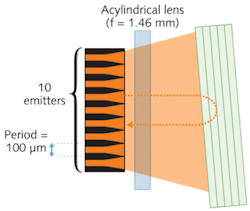Talbot external cavity coherently combines ten laser diodes
A method of phase-locking an array of ten index-guided tapered laser diodes has been devised by researchers at CNRS and the Alcatel-Tales III-V Lab (both in Palaiseau, France) and the University of Nottingham (Nottingham, England). The Talbot effect (a near-field diffraction effect in which a grating is repeatedly imaged at regular distances from the grating) is exploited by using a slightly tipped volume Bragg grating (VBG) as the output mirror; the tip selects an in-phase self-image and places it back on the diode array, sending light back into the diodes for phase-locking.
An acylindrical lens collimates the array’s fast-axis output. The VBG is designed to reflect 40% at the laser wavelength of 976 nm and has a spectral bandwidth of 0.3 nm, resulting in a laser bandwidth of 0.1 nm. The phase-locked laser array’s threshold current is 0.9 A; at a current of 3.9 A, the array reaches an output power of 1.7 W in its in-phase single main lobe mode. The far-field profile contains interference peaks, which at an output power of 1.2 W, are 1.2 mrad full-width at half-maximum (FWHM), close to the diffraction-limited width of 1 mrad. At higher power, the peaks broaden to 2.5 mrad FWHM. Contact David Paboeuf at david.paboeuf.institutoptique.fr.

